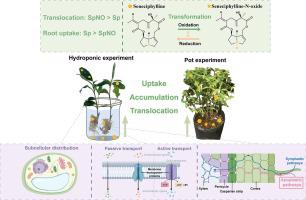当前位置:
X-MOL 学术
›
Environ. Int.
›
论文详情
Our official English website, www.x-mol.net, welcomes your
feedback! (Note: you will need to create a separate account there.)
Uptake, accumulation, translocation and transformation of seneciphylline (Sp) and seneciphylline-N-oxide (SpNO) by Camellia sinensis L
Environment International ( IF 10.3 ) Pub Date : 2024-05-21 , DOI: 10.1016/j.envint.2024.108765
Yuting Lu 1 , Haolei Han 2 , Changling Jiang 1 , Hongxia Liu 1 , Ziqi Wang 3 , Yunfeng Chai 4 , Xiangchun Zhang 4 , Jing Qiu 5 , Hongping Chen 4
Environment International ( IF 10.3 ) Pub Date : 2024-05-21 , DOI: 10.1016/j.envint.2024.108765
Yuting Lu 1 , Haolei Han 2 , Changling Jiang 1 , Hongxia Liu 1 , Ziqi Wang 3 , Yunfeng Chai 4 , Xiangchun Zhang 4 , Jing Qiu 5 , Hongping Chen 4
Affiliation

|
Pyrrolizidine alkaloids (PAs) and their N-oxide (PANOs), as emerging environmental pollutants and chemical hazards in food, have become the focus of global attention. PAs/PANOs enter crops from soil and reach edible parts, but knowledge about their uptake and transport behavior in crops is currently limited. In this study, we chose tea ( L.) as a representative crop and Sp/SpNO as typical PAs/PANOs to analyze their root uptake and transport mechanism. Tea roots efficiently absorbed Sp/SpNO, utilizing both passive and active transmembrane pathways. Sp predominantly concentrated in roots and SpNO efficiently translocated to above-ground parts. The prevalence of SpNO in cell-soluble fractions facilitated its translocation from roots to stems and leaves. In soil experiment, tea plants exhibited weaker capabilities for the uptake and transport of Sp/SpNO compared to hydroponic conditions, likely due to the swift degradation of these compounds in the soil. Moreover, a noteworthy interconversion between Sp and SpNO in tea plants indicated a preference for reducing SpNO to Sp. These findings represent a significant stride in understanding the accumulation and movement mechanisms of Sp/SpNO in tea plants. The insights garnered from this study are pivotal for evaluating the associated risks of PAs/PANOs and formulating effective control strategies.
中文翻译:

茶树对千叶茶碱(Sp)和千叶茶碱-N-氧化物(SpNO)的摄取、积累、易位和转化
吡咯里西啶生物碱(PAs)及其氮氧化物(PANOs)作为新兴的环境污染物和食品中的化学危害,已成为全球关注的焦点。 PA/PANO 从土壤进入作物并到达可食用部分,但目前对其在作物中的吸收和运输行为的了解有限。在本研究中,我们选择茶(L.)作为代表作物,Sp/SpNO作为典型的PAs/PANOs来分析其根部吸收和运输机制。茶根利用被动和主动跨膜途径有效吸收 Sp/SpNO。 Sp 主要集中在根部,SpNO 有效地转移到地上部分。 SpNO 在细胞可溶部分中的普遍存在促进了其从根到茎和叶的易位。在土壤实验中,与水培条件相比,茶树对 Sp/SpNO 的吸收和运输能力较弱,这可能是由于这些化合物在土壤中的快速降解所致。此外,茶树中 Sp 和 SpNO 之间值得注意的相互转化表明茶树倾向于将 SpNO 还原为 Sp。这些发现代表了理解茶树中 Sp/SpNO 的积累和运动机制的重大进步。这项研究获得的见解对于评估 PA/PANO 的相关风险和制定有效的控制策略至关重要。
更新日期:2024-05-21
中文翻译:

茶树对千叶茶碱(Sp)和千叶茶碱-N-氧化物(SpNO)的摄取、积累、易位和转化
吡咯里西啶生物碱(PAs)及其氮氧化物(PANOs)作为新兴的环境污染物和食品中的化学危害,已成为全球关注的焦点。 PA/PANO 从土壤进入作物并到达可食用部分,但目前对其在作物中的吸收和运输行为的了解有限。在本研究中,我们选择茶(L.)作为代表作物,Sp/SpNO作为典型的PAs/PANOs来分析其根部吸收和运输机制。茶根利用被动和主动跨膜途径有效吸收 Sp/SpNO。 Sp 主要集中在根部,SpNO 有效地转移到地上部分。 SpNO 在细胞可溶部分中的普遍存在促进了其从根到茎和叶的易位。在土壤实验中,与水培条件相比,茶树对 Sp/SpNO 的吸收和运输能力较弱,这可能是由于这些化合物在土壤中的快速降解所致。此外,茶树中 Sp 和 SpNO 之间值得注意的相互转化表明茶树倾向于将 SpNO 还原为 Sp。这些发现代表了理解茶树中 Sp/SpNO 的积累和运动机制的重大进步。这项研究获得的见解对于评估 PA/PANO 的相关风险和制定有效的控制策略至关重要。































 京公网安备 11010802027423号
京公网安备 11010802027423号